What is the Buyer Persona and How to build one?
Targeting customers precisely is not a walk in the park, particularly in these days of fierce competition. It takes tactical business strategies to attract and persuade buyers to pay for your product or service. But how can you know who is the right customer for your business to attract?
The solution is to build a buyer persona. It will allow your teams to know more about your customers or users at a deeper level, which in turn boosts conversion rates. Personas are a significant building block for the effective marketing of your company. You’re not your customer, as the old saying goes. However, you have to make choices regularly that you believe will eventually help them.
In this article, I will share with you everything you need to know about the buyer persona, how you can build one, and some great examples for your reference. Let’s jump right into it.
What is a buyer persona?

A buyer persona is essentially a research-based profile that represents your target consumer. The buyer persona will explain who your potential customers are, their preferences, what problems they face, and how they make decisions.
It is not uncommon to have several buyer personas for a business. For example, if the end-user of your product wants to obtain the approval of others before making a purchase, each entity involved in that decision is a different person. They’re going to have different expectations for assessing your product and you’re going to need different tactics to meet those needs.
Buyer personas are often referred to as a customer or a marketing persona (or profile), but the meaning is the same regardless of which term is used. Buyer personas help companies recognize and value their customers so that they can do a better job of attracting and satisfying them.
Why is it important to build a buyer persona?

Buyer Personas can help you make sure that all activities involved in your customers’ acquisition and service are customized to the needs of the target buyer. It may sound like a no-brainer, but it’s not as easy as it sounds. If you pay attention to the way businesses introduce themselves, you will start to notice that many of them start talking about what they do – not what the consumer wants. This sets them at odds with the way people make decisions.
When choosing a product or service, people instinctively gravitate towards companies they know and trust. The best way to build trust is to display sincere empathy and consideration for the other party – the customer, in this case. Achieving confidence as a company involves a subtle yet significant change in the way you present yourself.
This means you need to show your future customers that you get them by resolving their discomfort or need — only then would they be open to discovering what you have to give. Creating a buyer persona and using them continuously to direct your company will help keep you focused on your customers’ needs.
How to build a buyer persona?
Step 1: Do thorough customer research
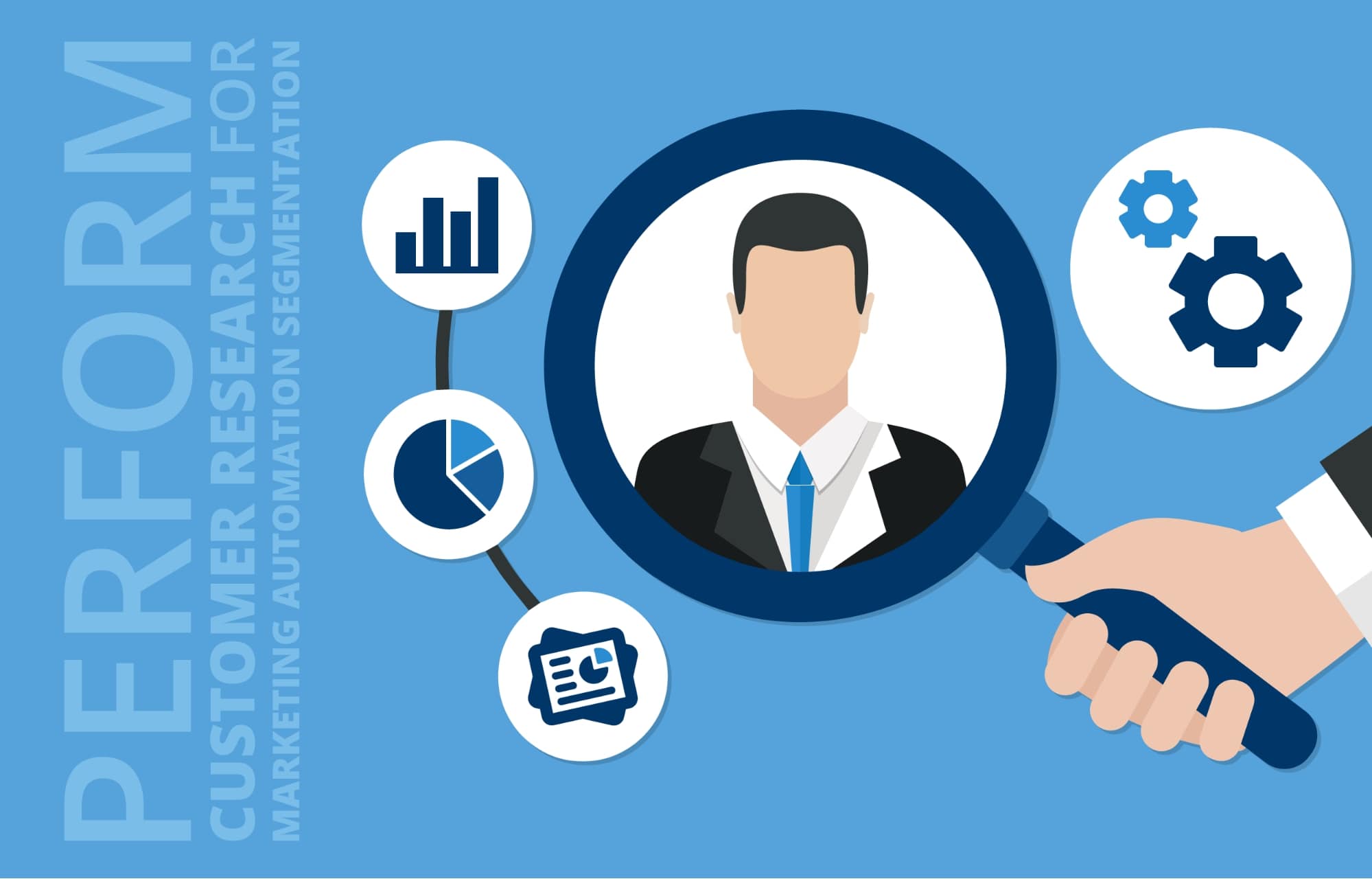
Your buyer persona will help you structure your marketing messages for a particular audience, ensuring that your messages are relevant to the customer’s needs, their objectives, and favorite content consumption channels. In reality, according to the Cintell study, 71 percent of companies that surpass sales and lead objectives have built their own buyer personas.
But how can you go about creating your buyer persona? Again, personas are dependent on research. Although different businesses have different ways to create buyer personas, many gravitate towards the same collection of questions when they do their customer research. Here’s a rundown of the details you need to identify when you do customer research to build your buyer persona.
Please note that this is general guidance for building a buyer persona, and the information below won’t necessarily apply to every industry. You should use this guide only as a starting point and apply insights from your industry to it.
Role and job title questions
These are questions such as:
- What does your ideal buyer do for a living?
- How much do they typically earn?
- Do they need approval from C-suite members such as CEOs, CFOs, or other top executives? (This is a B2B question)
- Who do they report to, if there’s any? (This is a B2B question)
The answers to these questions rely on your business objectives. For example, suppose your company serves a primarily B2B market. In that case, you can presume that your audience is made up of business decision-makers – individuals in control of procurement and purchasing decisions.
As you answer these questions and building up your customer persona, you can include additional information such as (if need be, of course):
- Professional background
- Educational attainment
- Skills
- Position in the organization
This information, in turn, will help you decide the totality of your marketing messages and what kind of language you should use.
Responsibilities and daily activities
These are questions such as:
- What tasks make up an ordinary workday for them?
- What is a typical day in your buyer’s life like?
- What skills do they need to do their job?
These questions will help you understand the motivations and challenges of your potential customers. Some questions will, of course, apply in some cases, and others will not. These queries, for example, presume that your customers are employed. In this situation, feel free to reframe the questions according to your objectives.
Media consumption habits
These are questions such as:
- How much time does your target customer spend on social media?
- What kind of content are they into?
- What form of content do they like? Videos, blogs, images?
- What is their favorite social media platform?
- Where do they get their news?
These questions help you find out what kind of content your ideal customers consume on a regular basis and where they’re going online for news and information. Answering these questions can be the difference between your company posting on LinkedIn or Facebook or making mostly video content.
Demographics and firmographics
These are questions such as:
- What is the average age of your buyers?
- What is their relationship status?
- For companies, what kind of industry are they in?
- What challenges do they typically face in their industry?
Demographic data may seem insignificant, but it can help you frame your messages for a particular age group. For instance, millennials tend to pay more attention to prices and prefer to splurge on holidays, concerts, and live sporting events. On the other hand, Firmographic data lets you determine if an entity has an unmet need that your company can solve. This data is especially useful for B2B customers.
Purchase factors that influence their decision to buy
These are questions such as:
- What factors influence your customers’ purchasing decisions? Price? Discount? Limited-time offers? Convenience?
- What factors can catch the attention of your customers? Benefits? Price? Design?
Answering questions in these aspects will help you frame your message to prioritize your marketing key messages such as product features or benefits, based on what your customers care about most. If valued at a profit, your marketing messages will place your company as the best value for money. If your audience values after-sales help or value-added services such as free shipping, you can change your marketing messages accordingly.
Goals and motivations
These are questions such as:
- What are your customers’ personal goals?
- What are their professional goals?
- What are their motivations?
As with any other individual, the potential customers are motivated by personal and professional; objectives and motivations. Taking the time to consider these priorities helps you to see if the marketing objectives of your company are aligned with theirs. The more stuff your ambitions have in common with theirs, the easier it will be to craft marketing messages that are aligned with your audience. Not to mention that, in reality, it lets you solve the problems of your prospects, ensuring satisfaction with your product or service.
Assume, for example, that your buyer persona is a procurement officer for a small graphic design business. Its work’s objectives include maintaining strong communications with suppliers and obtaining the best prices for raw materials and B2B service. You can use this information to craft your marketing message and product presentation to fit the perception of this buyer persona.
Values
- These are questions such as:
- What values or principles do your customers strongly believe in?
- What are the typical characteristics of your customers’ personalities?
You can dig deeper into the characteristics that characterize your future customers’ personalities, worldviews, and beliefs. These variables, also known as psychographics, fill in the information that helps you classify your customers’ views, viewpoints, and ideas.
Psychographic data is especially useful for generating marketing messages that appeal to your audience’s heart and soul – something that demographic data cannot capture. These qualitative variables can allow you to know what your audience deeply cares about and how your brand can use this to communicate with them on an emotional level.
Pain points and challenges
These are questions such as:
- What challenges are preventing your customers from achieving their goals?
- What problems do your customers frequently encounter?
Apart from the objectives and motives, it is also crucial to figure out which factors are frustrating the customers. If you find this out, it’s easier to understand what the hearts and minds of your audience will follow. One of the main reasons for building buyer people is that it allows teams to think about communicating the advantages of their product or service to the real people who will use it. In other words, it forces you to think of them as individuals, not just consumers or customers or abstract concepts. This also makes you think about how to give real value to your customers, which is basically what they care about.
Finding answers to the mentioned questions is only the beginning. There are still other things you need to find out, particularly as you get to know more about your customers. Over time, be sure to add or adjust factors such as abilities, influences, preferred brands, and even the tech that your persona uses to make the description of your customer persona more accurate.
Step 2: Understand how you can help

Now that you understand your buyers’ pain points and goals, it’s time to get a better picture of how your goods and services will help them. As part of this step, you will need to avoid thinking about your brand in terms of features and dig deeper to analyze the benefits you bring to customers.
It can be hard for marketers to get out of their feature thinking—which is one reason having a buyer persona is so essential. It helps you change your perspective and see your goods and services from a buyer’s perspective. It’s a function of what the product is or does. A benefit is how your product or service makes life simpler or better for your customer.
Ask yourself these three questions about each of the pain points and goals you have collected:
- How can you help your customer resolve their problem with your product? Capture this in a concise sentence and apply it to your buyer persona.
- What are the biggest obstacles that prevent your customer from buying? And how are you going to deal with them?
- Where are your followers on their journey to purchase? Are they doing their research, or are they ready to buy? Are they looking for reviews and testimonials?
On top of this, talking to your co-workers who work directly with customers can be a great way to acquire more information. It can also be a good idea to gain data by surveying your customers and social fans directly on social media with questionnaires.
Step 3: Create your buyer persona
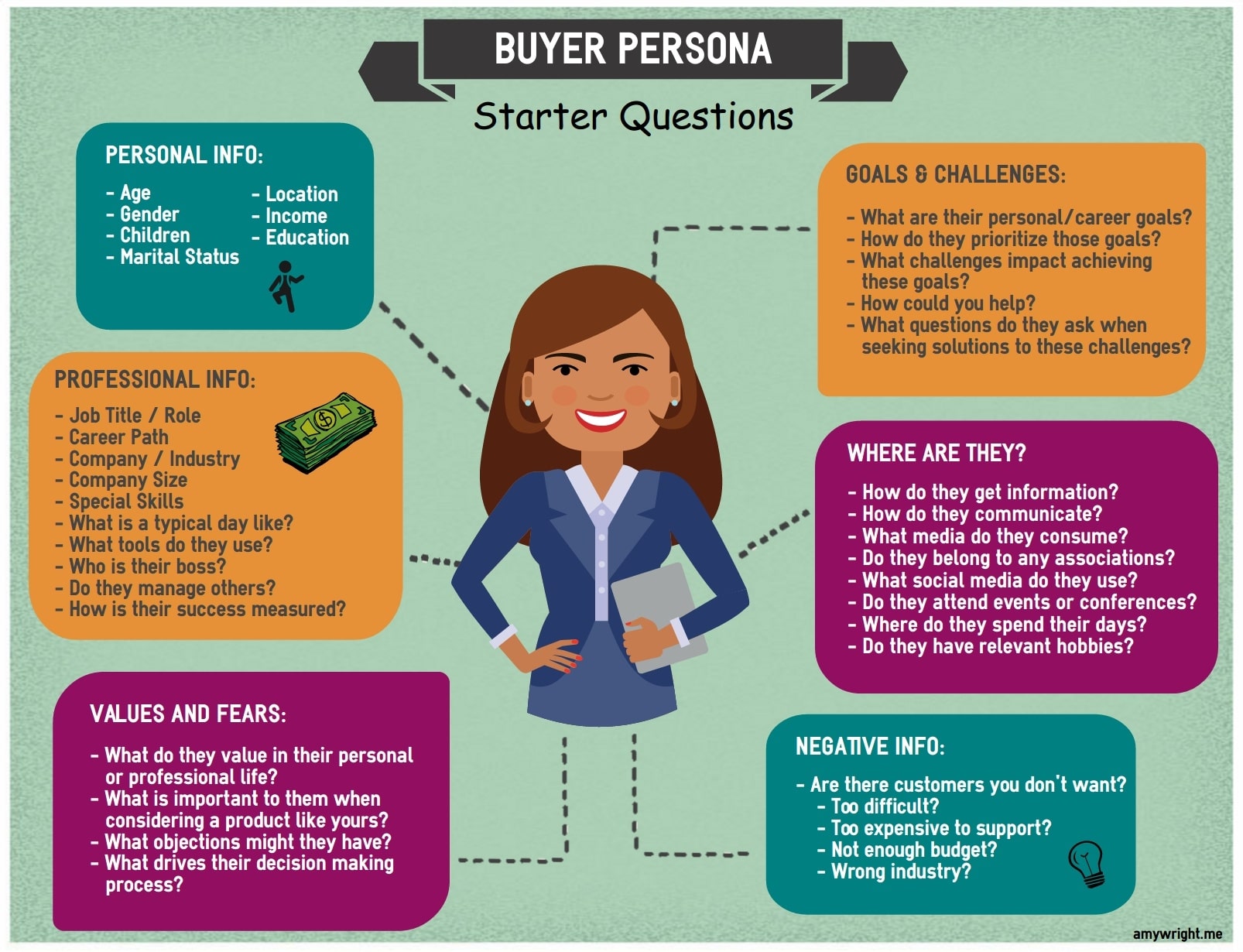
Now, put together all your research and start looking for common patterns. When you group these patterns together, you’re going to have the foundation of your ideal customer. Let’s assume that you recognize that your ideal customer is fathers in their 30s who live in big cities, enjoy camping, and own motorcycles. Great—now it’s time to take this abstract set of features and transform them into a buyer persona you can communicate with.
Give your buyer a name, a title, an avatar picture, and other distinguishing characteristics. You want to make your person look like a real person. Aim for the amount of detail you’d like to see on a dating site. Or what you might learn from a brief talk on a plane or a bus stop. Don’t forget to include the information you’ve collected in step 1. Now let’s look at some examples of buyer personas to visualize all the theories that you’ve learned.
Examples of buyer personas
B2C Buyer Persona Examples
Let’s start by looking at a few examples of B2C or Business-to-Customer Persona. In this situation, you are selling directly to the end consumer – a person who uses his or her own money and choice to make purchase decisions.
If you’re supposed to provide job specifics in a B2C buyer persona, you don’t have to share as much information about their positions and duties as you would in a B2B buyer persona. Instead, you can concentrate more on who the person is in their day-to-day lives and how they make individual purchase decisions.
Propertyconnect.me
In this buyer persona from Propertyconnect.me, you can see that a persona doesn’t necessarily have to be lengthy to convey a picture.
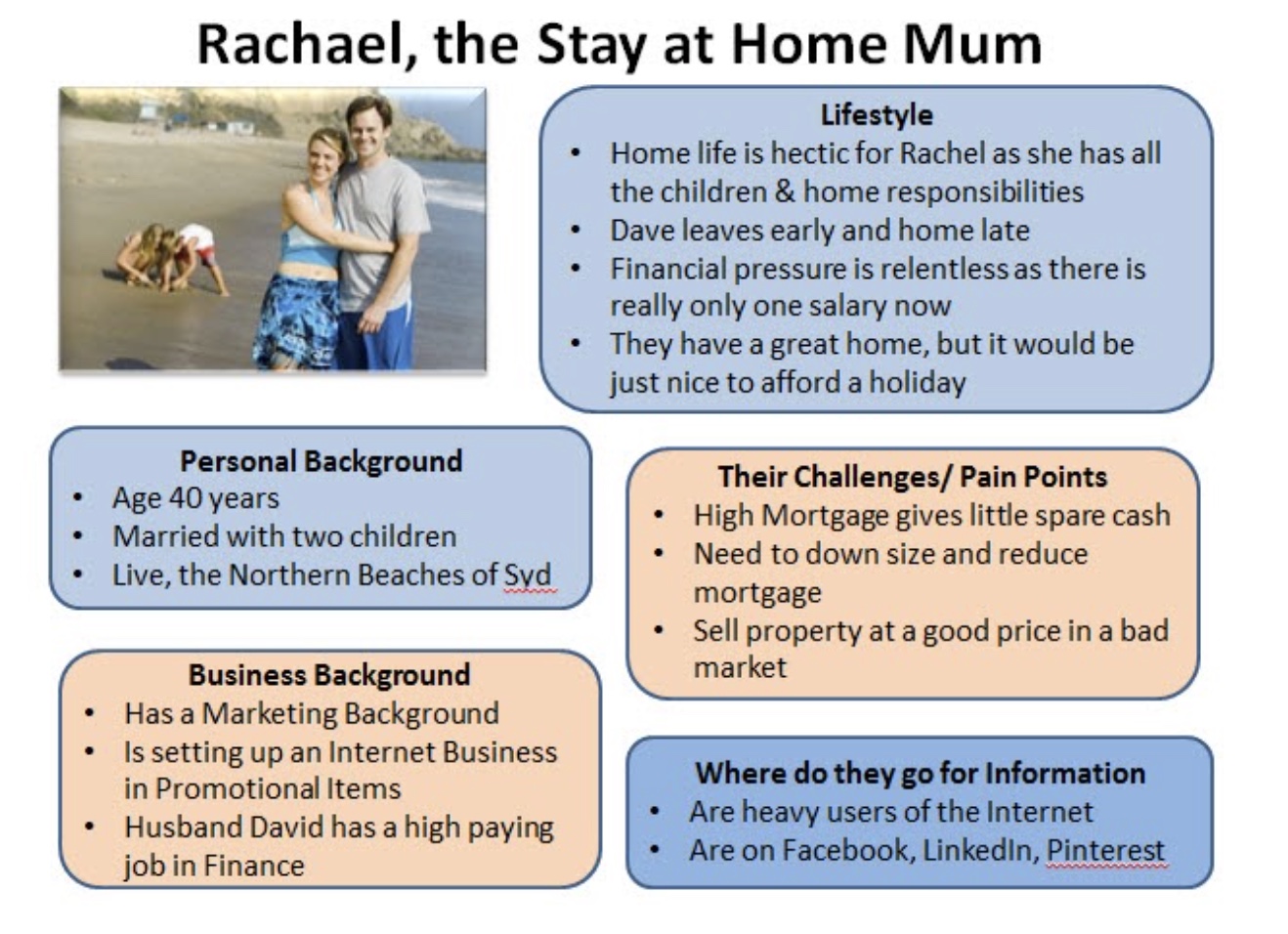
Via this short bullet-point description, you can get a clear idea of who Rachel is by learning about her past, her lifestyle, and her challenges. In just a few short bullet points, you can understand that she’s busy, on the budget, and in need of fast, easy solutions.
Indie Game Girl
Indie Game Girl also uses short descriptions to get to know their target customer, Brandi. The information helps them imagine the process the customer is going through when she’s buying shoes. The persona also provides something special to help them truly appreciate the frustrations of their target customer; it includes quotes from actual customers.
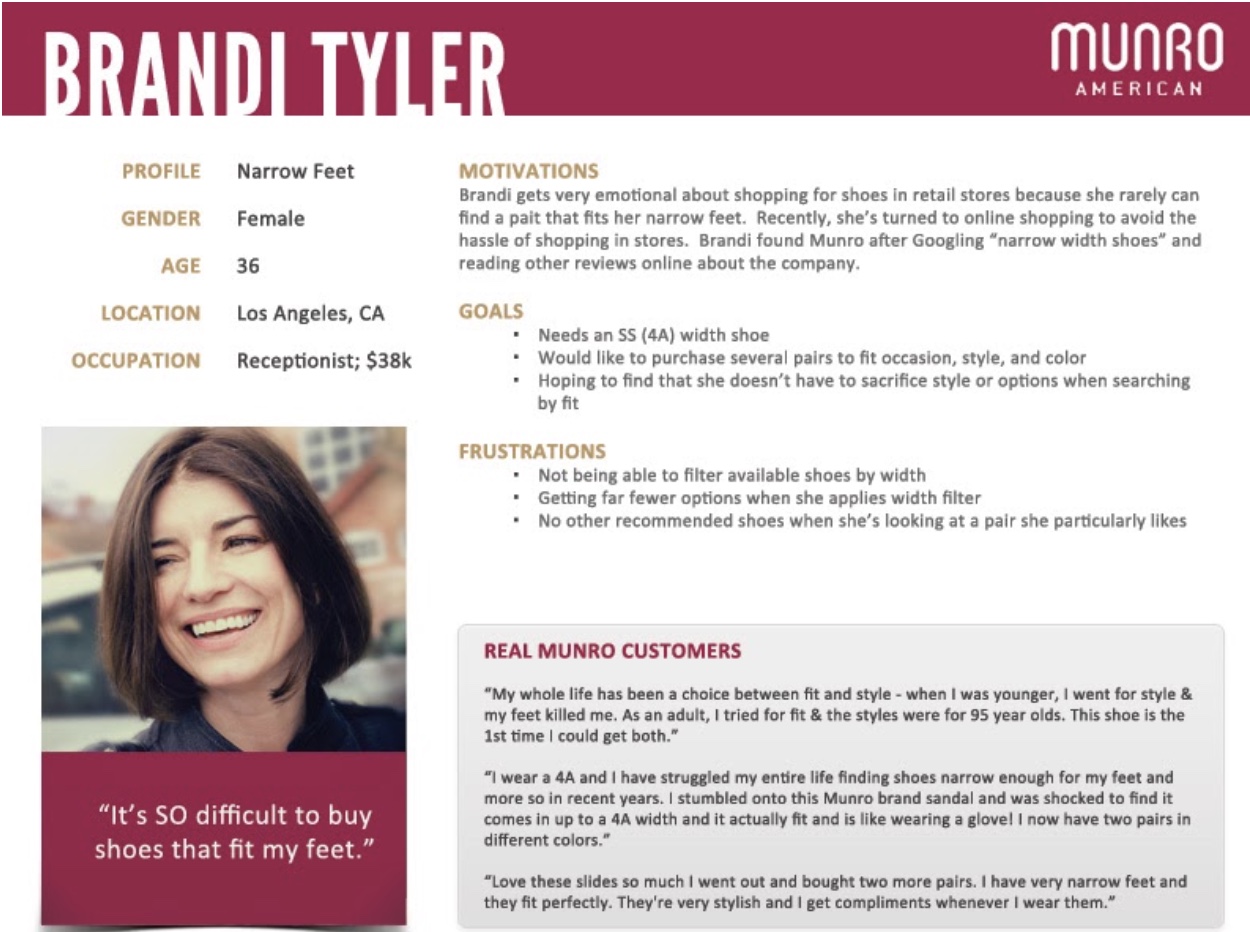
The business interviewed their customers and prospects to help build their buyer persona. Then, they used actual quotations to bring a touch of fact to their fictional character. When you put together your buyer, you may want to incorporate specifics from your research to give your explanations factual credibility.
Juny Lee
This example, published by Juny Lee, shows another way to use first-person statements to build a buyer persona.
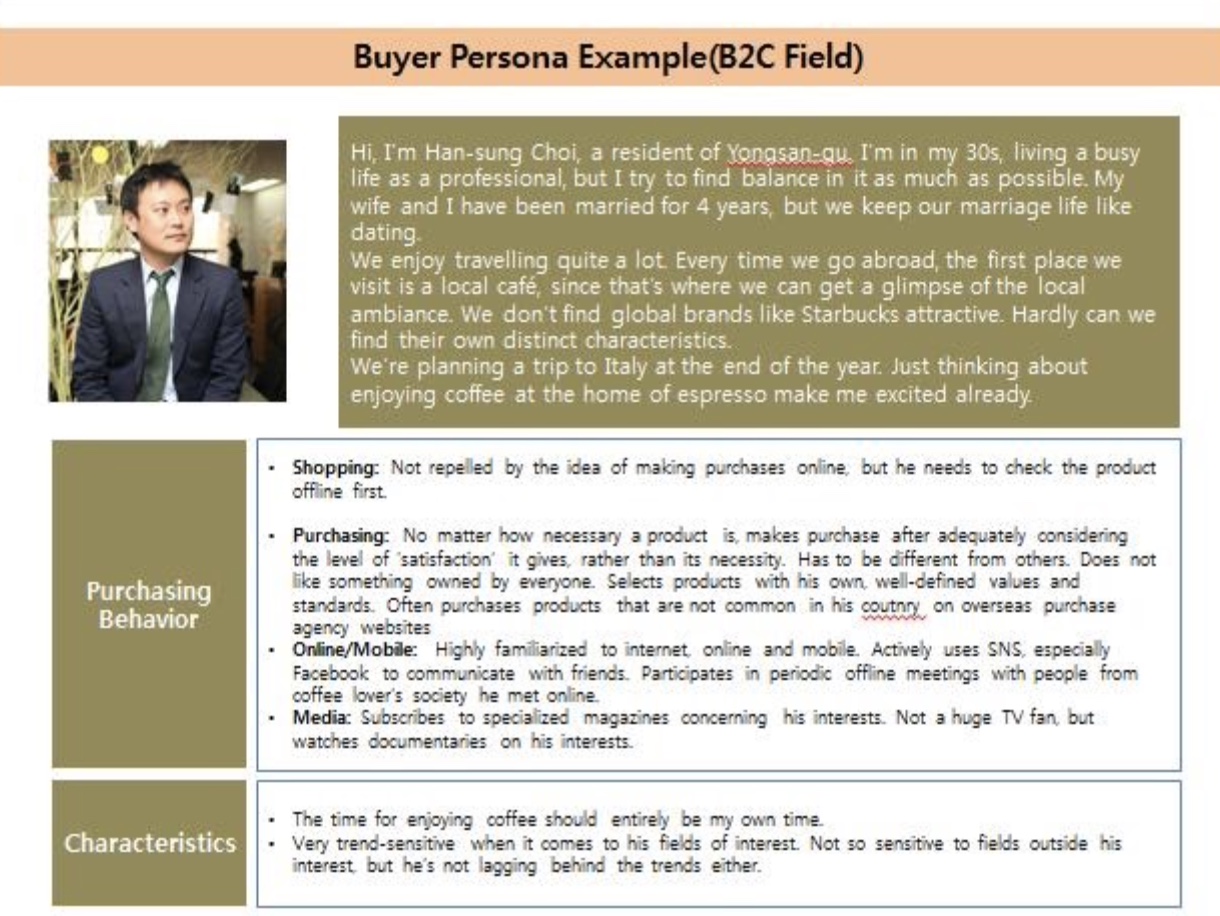
The person includes a fictional first-person comment that shares Han-point Sung’s view. Instead of using only bullet points, you can also add a first-person story to your persona to bring your character to life.
Inalign
In this buyer persona example, generated by Inalign, you will see how a brand can shape its persona in order to appeal to more specific product offerings.

While the definition includes Kyle’s features and characteristics, it also dives deeper into the parts of his life that are connected to his auto needs. As you build up your person, consider how you can tell stories and share information directly related to the goods, services, or solutions you deliver to your ideal customer.
B2B Buyer Persona Examples
In this section, let’s look at some buyer persona examples for B2B or business-to-business companies.
In this next group of buyer persona examples, Let’s look at customer descriptions for B2B companies. Similar to B2C examples, B2B buyer persona examples mainly focus on the individual customer. However, the examples include more specific details about where the target customer works, what they do, and how they interact with their organization. In this case, the customer persona is not always in charge of making the final purchasing decision, so those details should be a part of your description as well.
ClearVoice
This ClearVoice persona is an example of a short summary that contains all the necessary details for a B2B persona. It explains that John provides the requisite information about his job status and the ability to make decisions inside of his organization. Your persona can be short as long as it has all of the essential details.
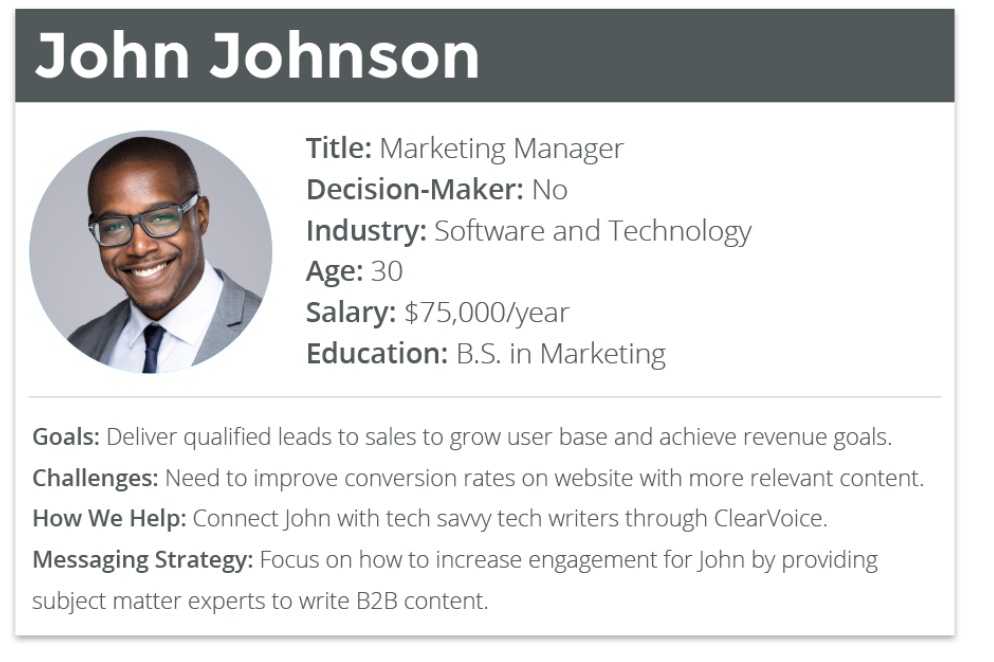
Referral Saasquatch
One of the buyer persona examples shared by Referral Saasquatch demonstrates how you can provide even more detail about buying decisions. It shows that the individual is the decision-maker and also the one who influences his buying choices.
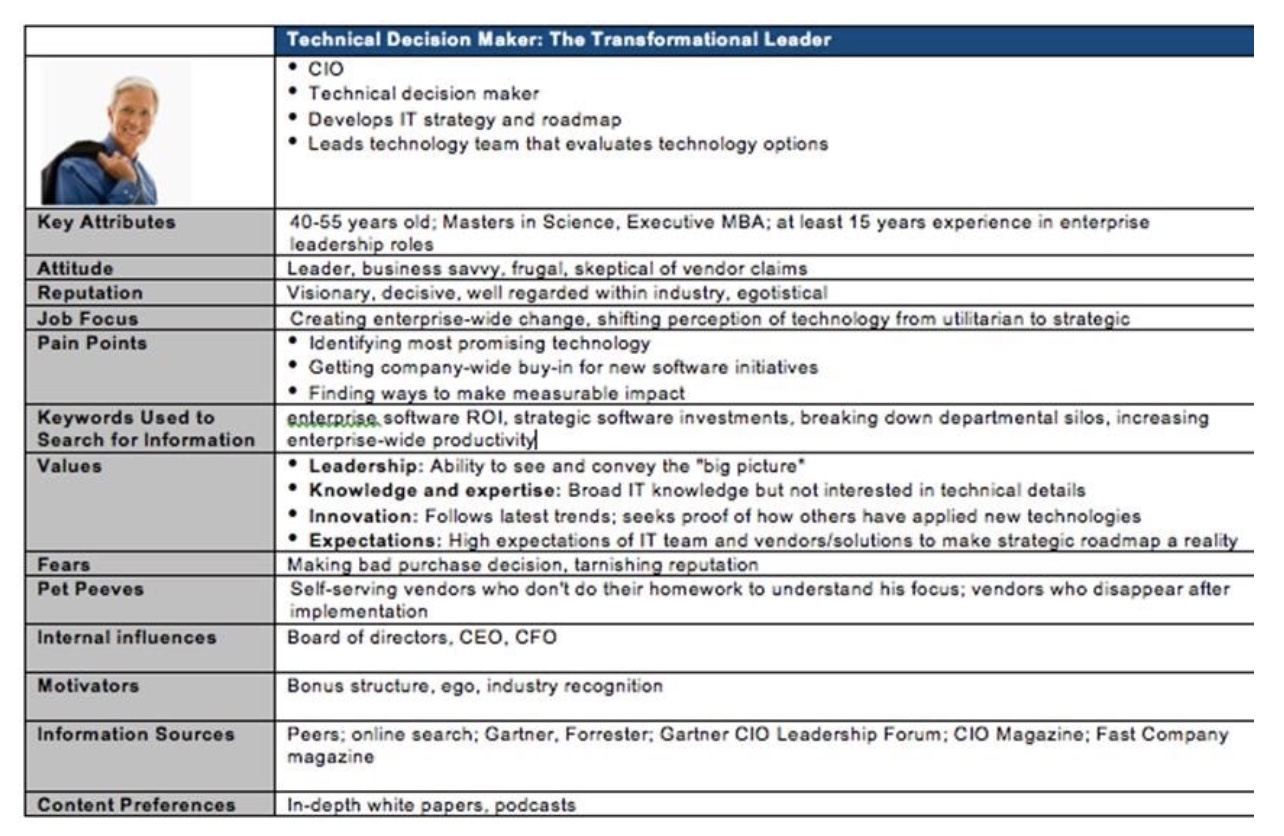
In the “internal influences” area, the brand lists key individuals who have an effect on the persona’s buying decisions within the organization. This is an important aspect that you may want to add to your buyer persona.
Marketing Insight
This next example of the B2B buyer persona presents how you can use a scale to explain the personality of your persona. The example of Marketing Insight involves a personality and technology scale that values its character and experience.
If you have several buyer personas, using a scale to each may be a good way to differentiate your unique set of ideal buyers.
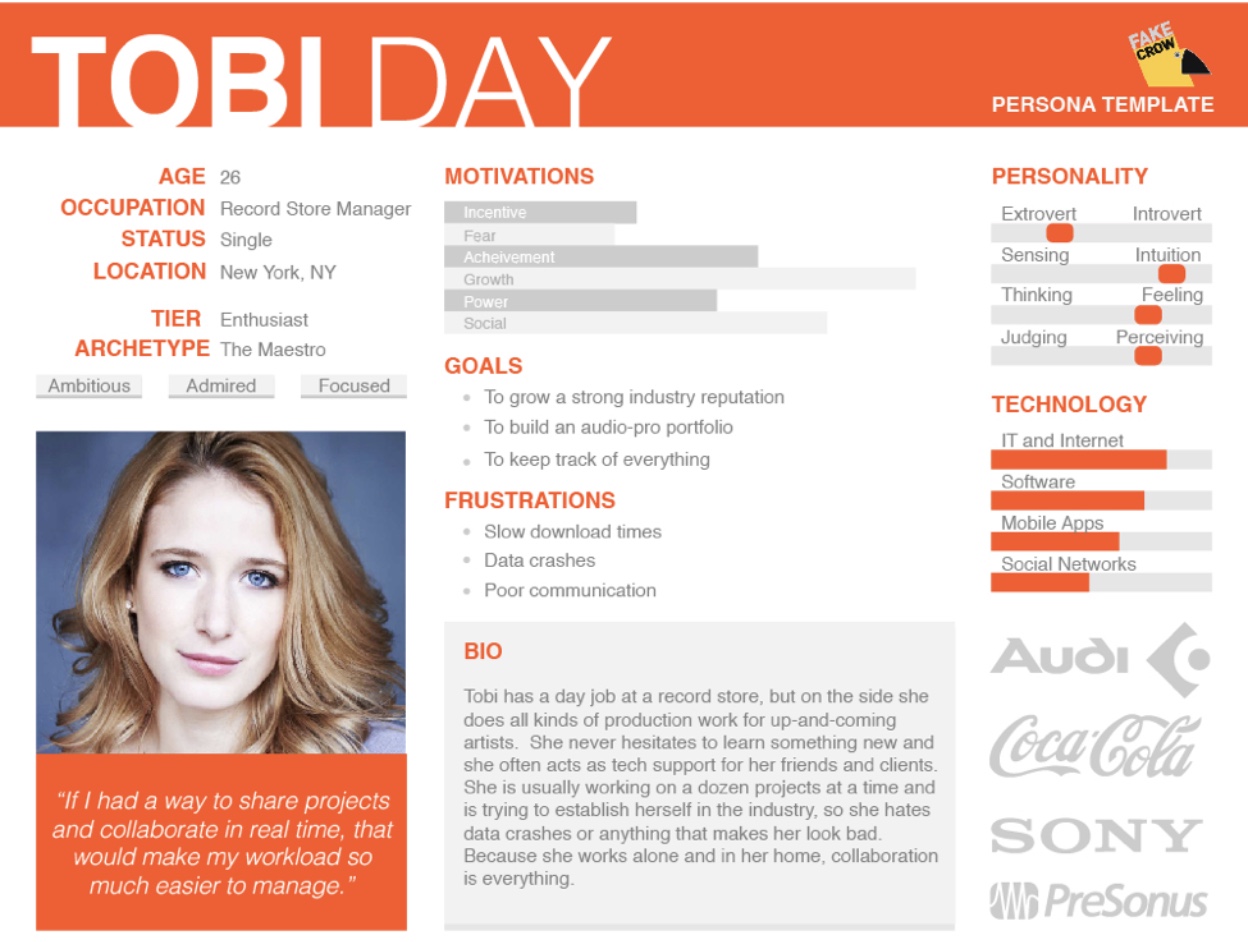
Buyer Persona Institute
The Buyer Persona Institute is another buyer persona example that uses lots of content in its description. The persona contains six tabs of information.
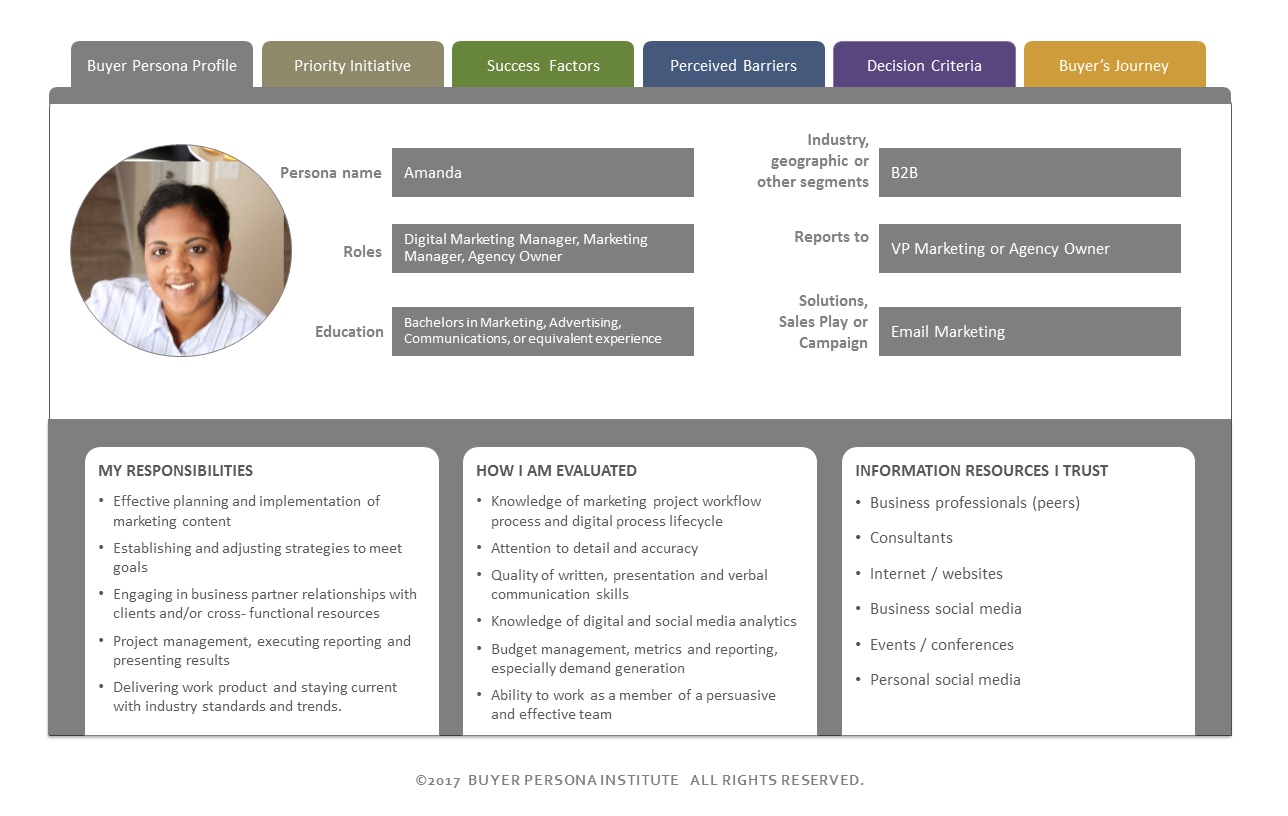
Although there’s a lot of details, the persona is broken down into bits, bullets, and tabs, making the content easier to comprehend. If you want to include a lot of information in your buyer persona, just make sure it’s easy to absorb.
Final words
That’s it! I hope this article about what a buyer persona is and how you can build one for your business has provided you with a lot of practical knowledge and tips. Please feel free to leave comments below for a further discussion on this topic!
New Posts







